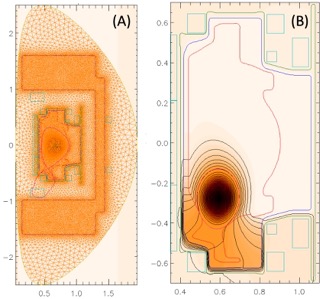Speaker
Description
Electromagnetic (and thermal) loads during vertical displacement events (VDEs) are of major concerns in tokamaks, and in future pilot plants that are based on this concept. In particular, Alcator C-Mod has been used to study disruptions from planned as well as unexpected VDEs, and where halo currents were well analyzed in the disrupting plasma [1,2]. Therefore, it offers comprehensive hot and cold VDE data that could be used to validate numerical codes. On the modeling side, M3D-C1 [3] is becoming a valuable tool to help inform SPARC and ARC physics/design. Therefore, validation of M3D-C1 with C-Mod VDEs data is critical to improve our predictive modeling capabilities. In this work, we present our efforts in modeling hot and cold VDEs with M3D-C1 on different C-Mod discharges. We generated different C-Mod models, including the massive dome and cylinder structures that surrounds the vacuum vessel, as well as ports. The figure below shows on the left panel an example of the M3D-C1 mesh model. Using the actual wall toroidal resistivities, we observe trends that qualitatively agree with experiments and that the massive dome and cylinder do not seem to play a role in the VDE dynamics. We also employed different assumptions on the poloidal wall resistivities scanning over different parameters of interest to better understand halo current magnitude and general VDE behavior on C-Mod. An example of simulated halo current patterns is shown in the right panel of the figure.

Acknowledgements
Work supported by Commonwealth Fusion Systems. The authors are also grateful to the support from J. Chen (PPPL) and E. S. Seol (RPI) on the installation of M3D-C1 in the new MIT cluster used for this work.
References
- R. Granetz et al., Nucl. Fusion 36 (1996) 545
- R.A. Tinguely et al., Nucl. Fusion 58 (2018) 016005
- S. Jardin et al., Comput. Sci. Disc. 5 (2012) 014002
| Speaker's title | Mr |
|---|---|
| Speaker's email address | cclauser@psfc.mit.edu |
| Speaker's Affiliation | Massachusetts Institute of Technology, Cambridge MA |
| Member State or IGO | United States of America |
